
Secure (Web) Coding
시큐어코딩
012744 • 2025년 1학기 • 대전대학교
Schedule 강의일정
| Date | Lecture | Content | Logistics | |
|---|---|---|---|---|
| 3/4 | 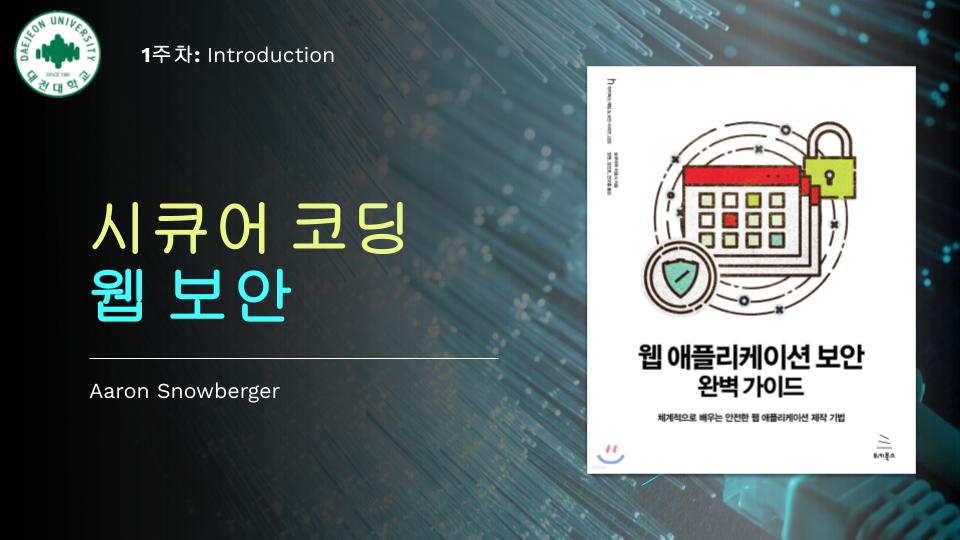 [ Additional #1 ] | Week #1: 01장: 웹 응용 프로그램 취약점이란?
| ||
| 3/11 | 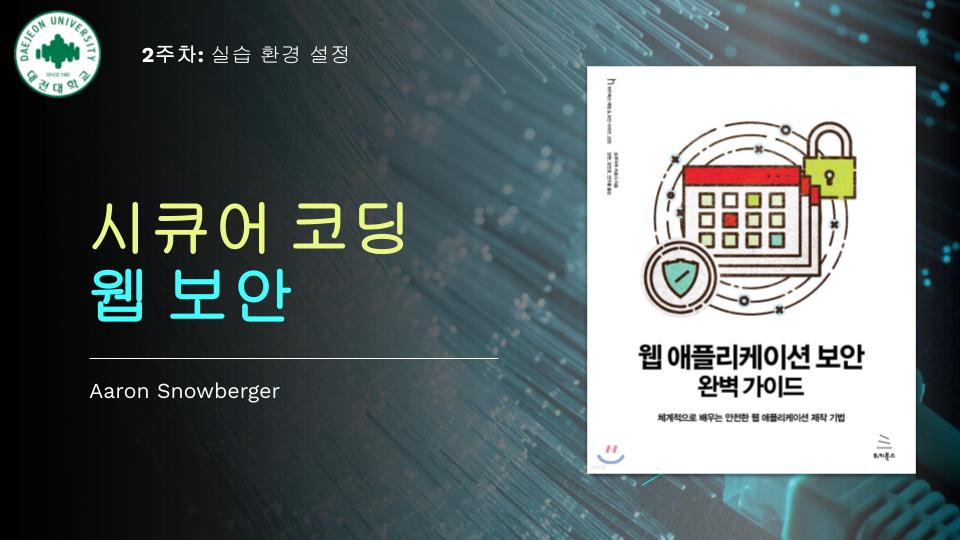 | Week #2: 02장: 실습 환경 설정
| ||
| 3/18 | 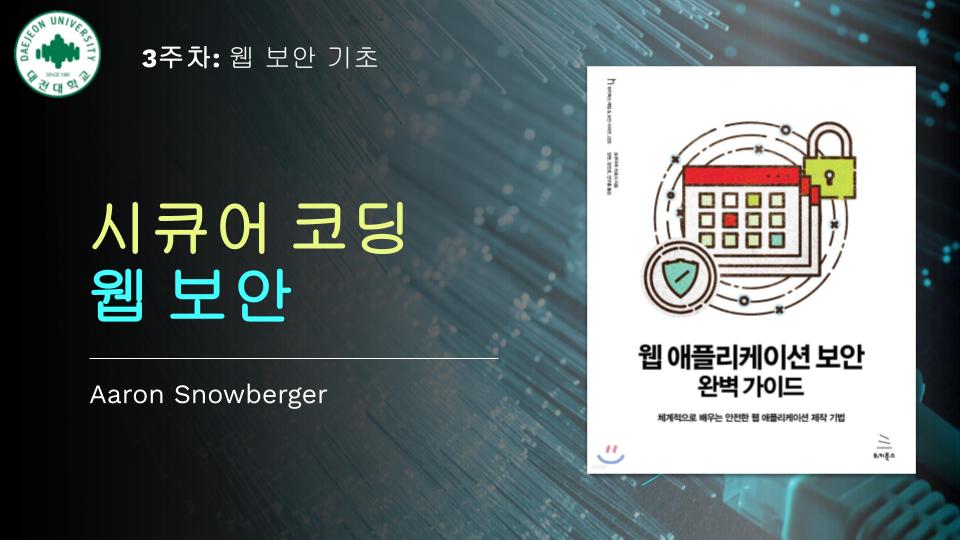 | Week #3: 03장: 웹 보안 기초 - HTTP, 세션 관리, 동일 출처 정책, CORS
| ||
| 3/25 | 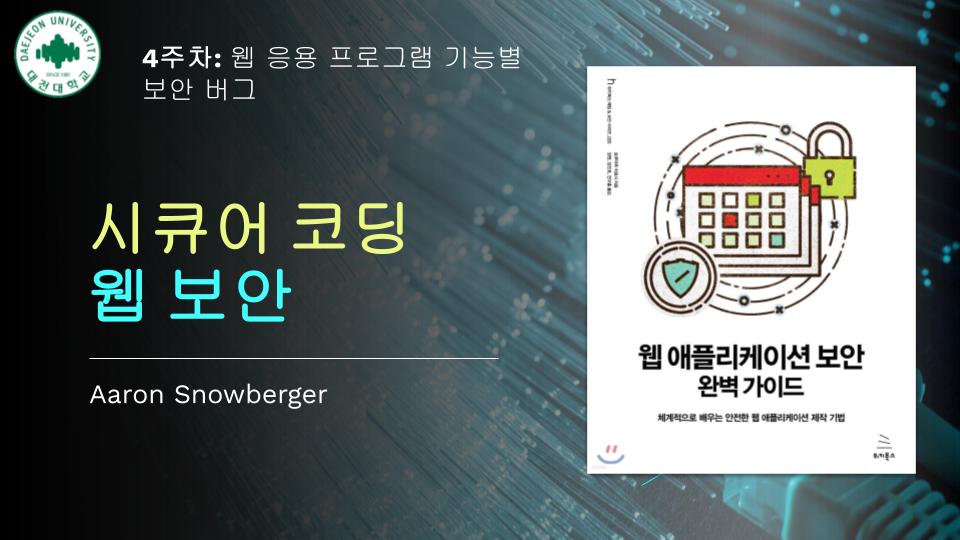 | Week #4: 04장: 웹 응용 프로그램 기능별 보안 버그, #1-2
| ||
| 4/1 | 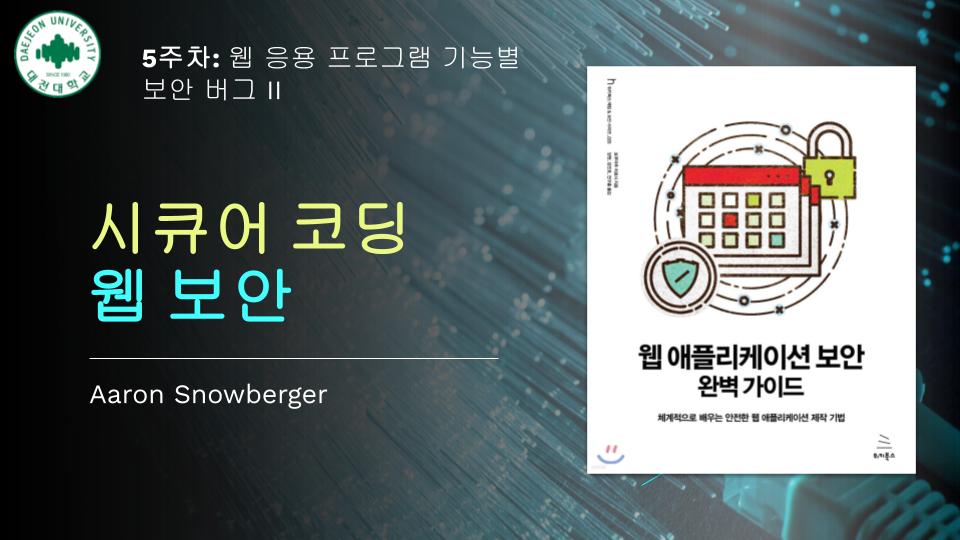 | Week #5: 04장: 웹 응용 프로그램 기능별 보안 버그, #3
| ||
| 4/8 | 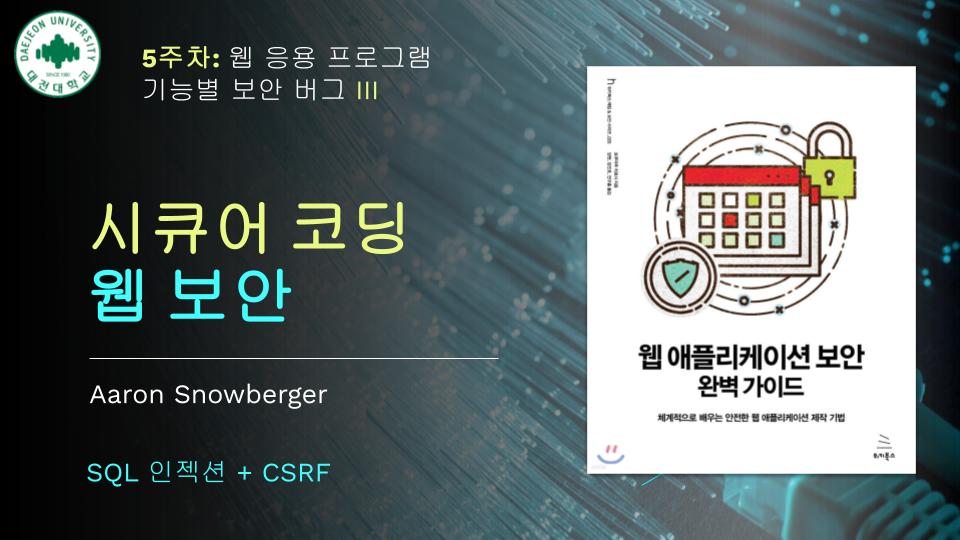 | Week #6: 04장: 웹 응용 프로그램 기능별 보안 버그, #4-5
| ||
| 4/15 | 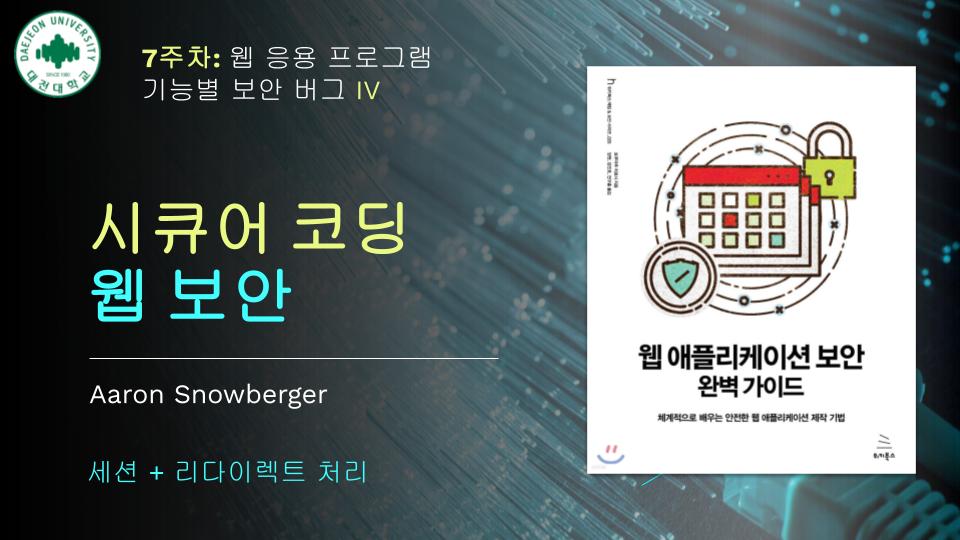 | Week #7: 04장: 웹 응용 프로그램 기능별 보안 버그, #6-7
| ||
| 4/22 | 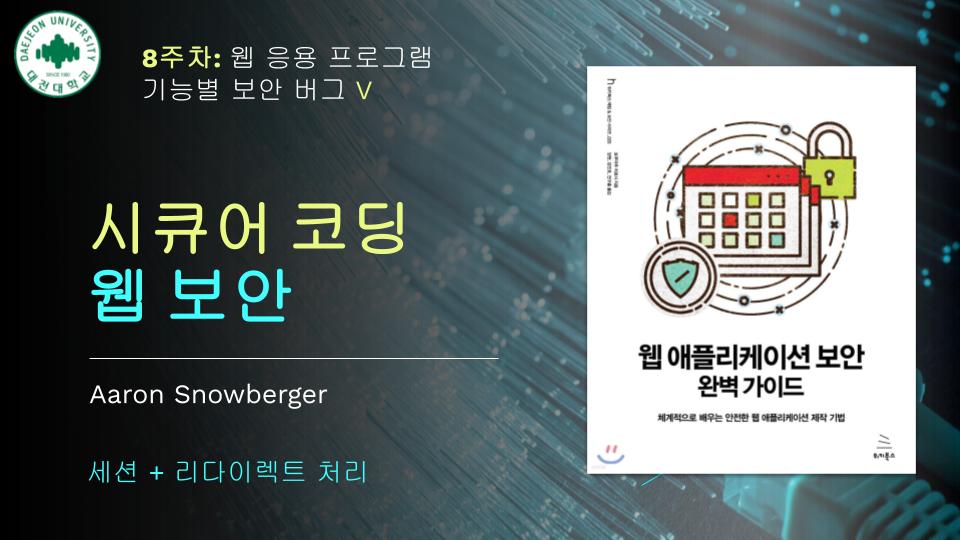 | Week #8: 04장: 웹 응용 프로그램 기능별 보안 버그, #8-10
| ||
| 4/29 | Midterm Test 퀴즈 | |||
| 5/6 | No Class 어린이 날 (대체) | |||
| 5/13 | 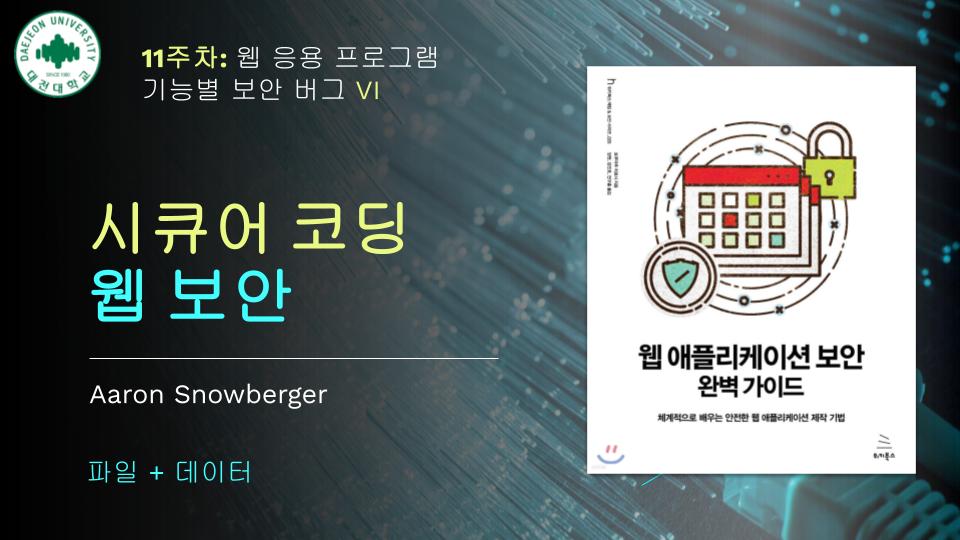 | Week #11: 04장: 웹 응용 프로그램 기능별 보안 버그, #11-13
| ||
| 5/20 | 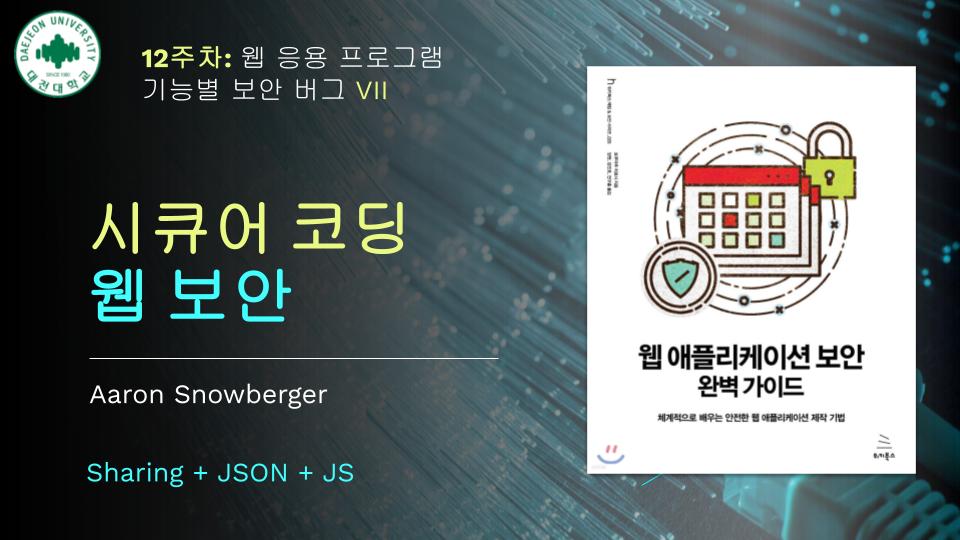 | Week #12: 04장: 웹 응용 프로그램 기능별 보안 버그, #14-17
| ||
| 5/27 | 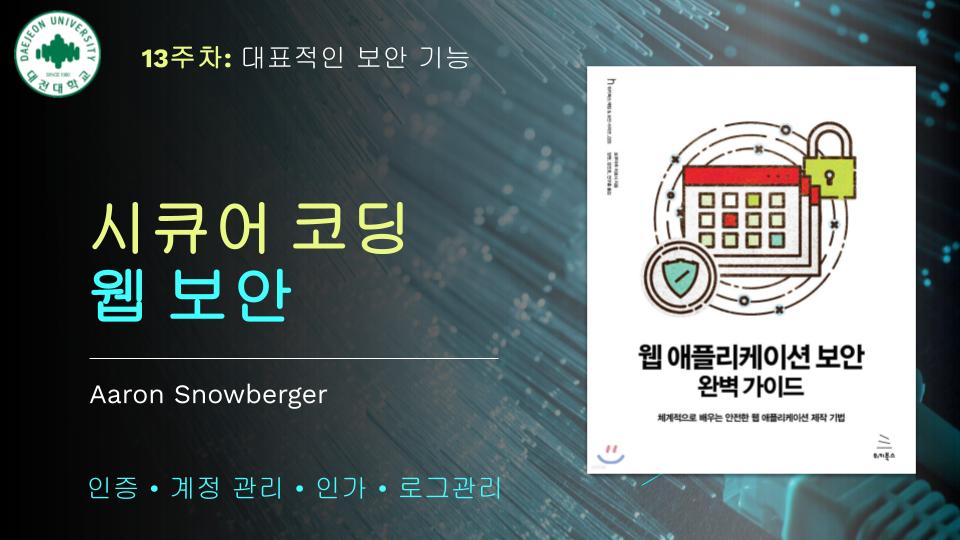 | Week #13: 05장: 대표적인 보안 기능 06장: 문자 코드와 보안
| ||
| 6/3 | No Class 선거 | |||
| 6/3 보강 | 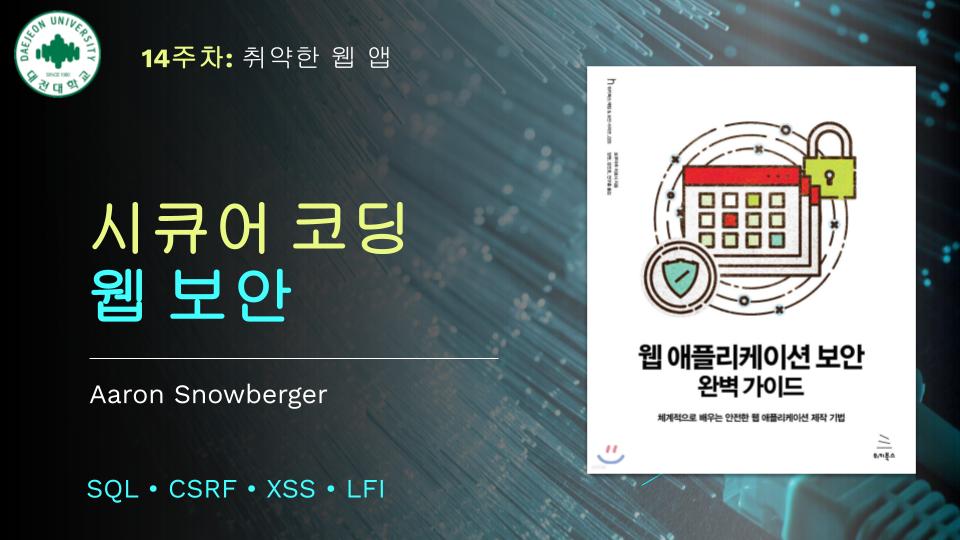 | Week #15: 취약한 웹 앱 수정
| [ 과제 ] | |
| 6/10 |  | Week #16: 기말고사 리뷰
| ||
| 6/17 | Final Test 퀴즈 | |||
Overview 개요
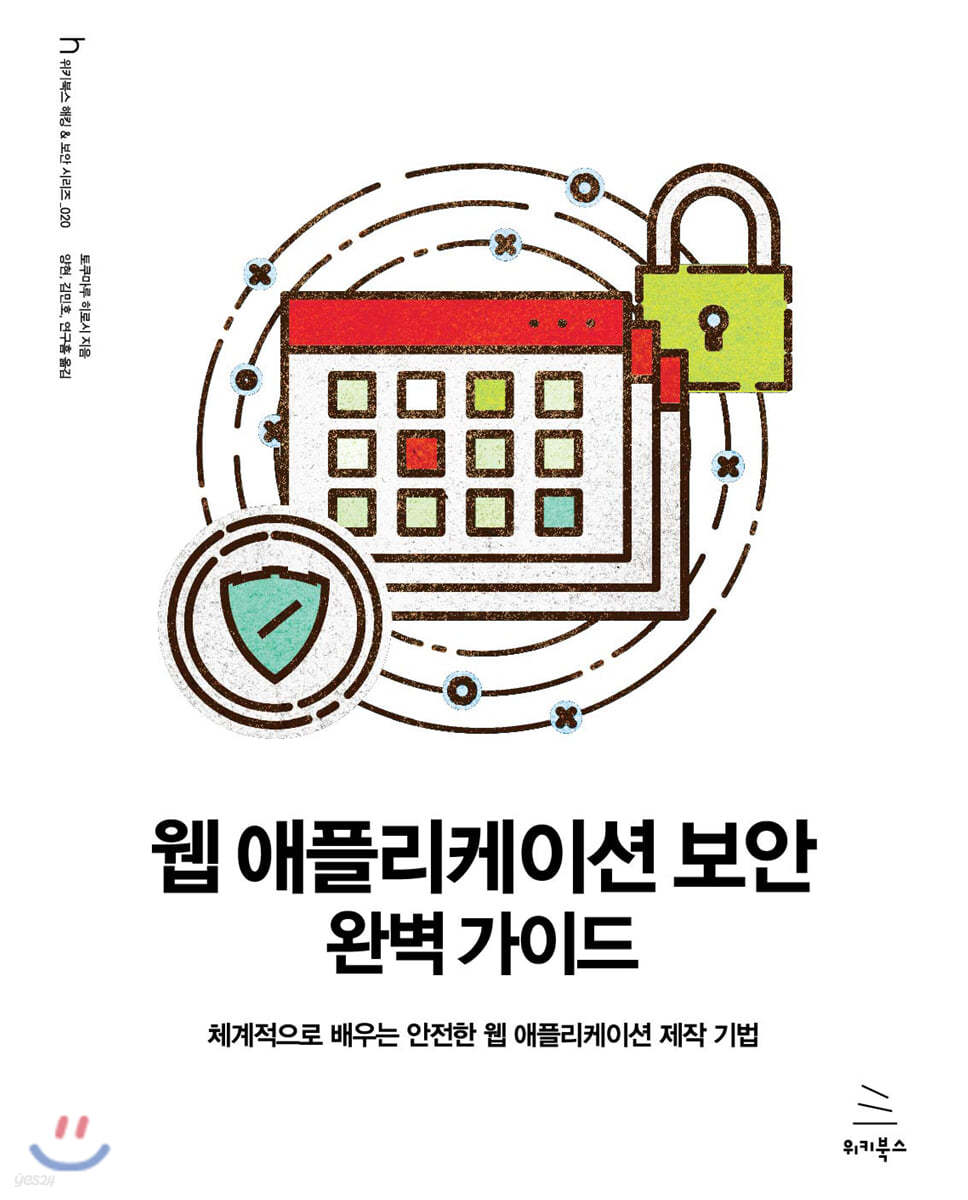
『웹 애플리케이션 보안 완벽 가이드』는 취약점을 최소화하기 위한 다양한 방법을 소개한다. 이 책에서는 PHP를 사용하지만 웹의 기본을 다루고 있어 다른 언어에서도 충분히 적용할 수 있는 내용을 다룬다. 4장까지는 PHP를 바탕으로 취약점을 소개하고, 취약점으로 발생할 수 있는 위협, 취약점을 없애기 위해 어떻게 개발해야 할지 예제 코드와 함께 상세하게 설명한다. 책에서 다루는 소스코드는 책과 함께 제공하는 가상 머신에도 포함돼 있으므로 책을 보면서 곧바로 실습을 진행할 수 있다. 5장 이후로는 개발 전 기획 단계에서 고려해야 할 기본적인 보안 기능과 직접 보안 진단을 하기 위한 방법들을 심도 있게 설명한다.
이 책은 웹 개발자뿐 아니라 보안 업계에 종사하는 웹 취약점 진단자에게도 유용한 내용이 수록돼 있어 진단 실무자에게도 유용할 것이다.
“Web Application Security: A Beginner’s Guide” introduces various methods to minimize vulnerabilities. This book uses PHP, but covers the basics of the web, so the content can be applied to other languages. Up to Chapter 4, vulnerabilities are introduced based on PHP, threats that can arise from vulnerabilities, and how to develop to eliminate vulnerabilities are explained in detail with example code. The source code covered in the book is also included in the virtual machine provided with the book, so you can practice immediately while reading the book. From Chapter 5 onwards, basic security features to consider in the planning stage of development and methods for direct security diagnosis are explained in depth.
This book contains useful content for web developers as well as web vulnerability diagnosticians working in the security industry, so it will be useful for diagnosticians in practice.
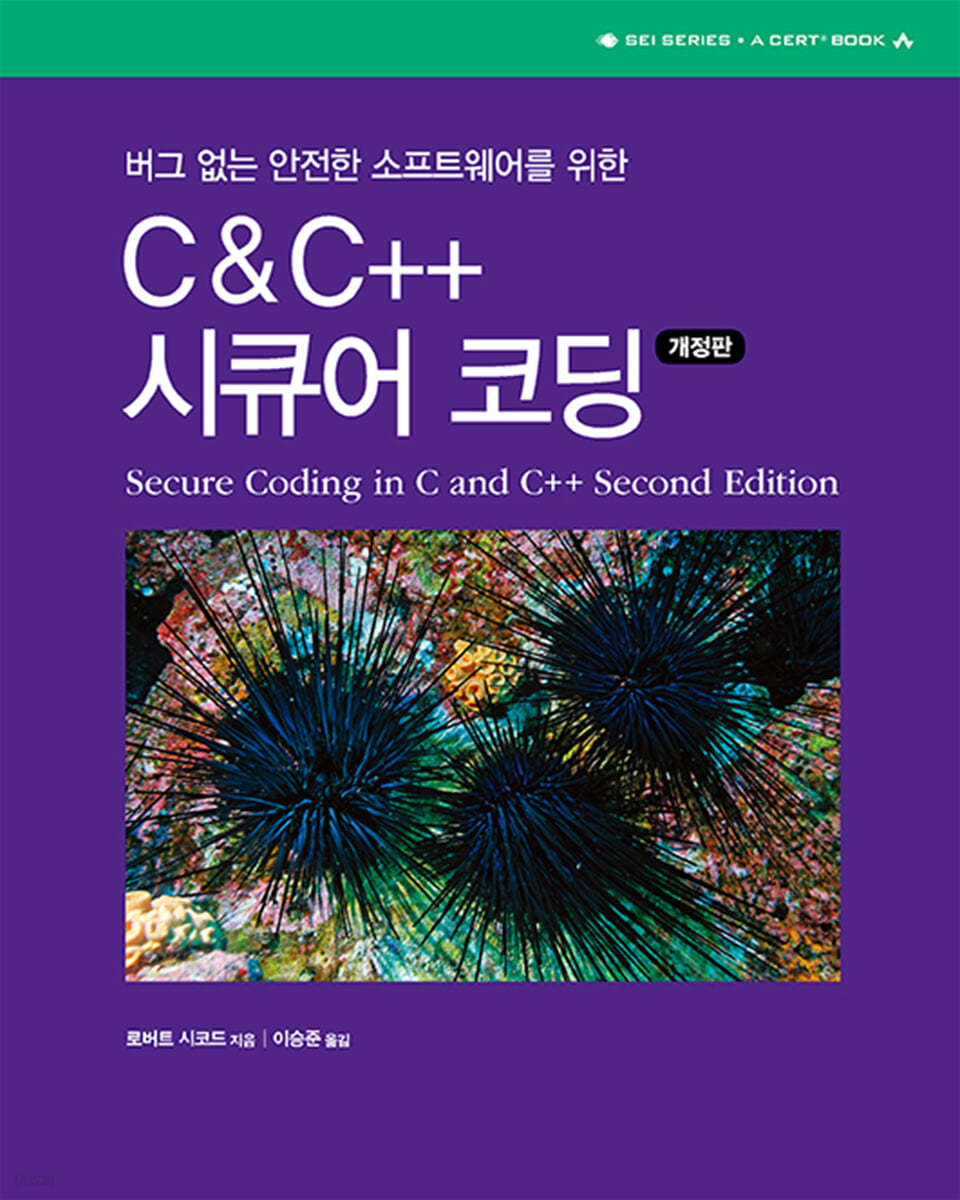
이 책은 소프트웨어 취약점의 근본 원인을 설명하고 침투를 막기 위해 취할 수 있는 대책을 알려준다. 더욱이 이 책을 통해 프로그래머는 당장 오늘만이 아니라 미래의 공격으로부터 소프트웨어를 보호하는 최상의 보안 업무 채택과 보안 사고 방식을 발전시킬 수 있다. 로버트 시코드는 CERT 보고서와 결론을 활용해 프로그램 에러가 대부분 보안 구멍이 되는 것을 체계적으로 확인하고, 그 보안 구멍이 어떻게 무단 이용될 수 있는지를 보이며, 가능한 결과를 고찰해보고 안전한 방법을 내놓는다. 이 책에는 윈도우와 리눅스에서 구현한 수백 개의 안전한 코드, 불안전한 코드, 익스플로잇 예제가 들어있다. 안전한 C 또는 C++ 소프트웨어를 만들(또는 안전하게 지킬) 책임이 있다면 이 책에서 가장 자세하고 전문적인 지원을 얻을 수 있다.
This book explains the root causes of software vulnerabilities and provides measures to prevent penetration. Moreover, through this book, programmers can adopt the best security practices to protect software from future attacks, not just today, and develop a security mindset. Robert Seacord systematically confirms that most program errors become security holes using CERT reports and conclusions, shows how those security holes can be exploited, reflects on possible outcomes, and offers safe methods. This book contains hundreds of secure, insecure, and exploit examples implemented in Windows and Linux. If you are responsible for creating (or safely maintaining) secure C or C++ software, you can get the most detailed and professional support from this book.
Textbook 교재
 |
|
|---|---|
 |
|
Policies 규정
Grading Curve 성적평가
- 출석: 10%
- 중간고사: 25%
- 기말고사: 30%
- 과제 (연습문제, 실습코드, 등): 30%
- 핵심역량평가: 5%
Grading 평가방법
Most of my courses are graded based on the following components. Please note that the weights of each component may vary depending on the course. The grading policy will be announced in the first class and will be available on the course website.
대부분의 강의는 다음 구성요소에 따라 평가됩니다. 각 구성요소의 가중치는 강의에 따라 다를 수 있습니다. 평가 방법은 첫 강의에서 발표되며 강의 웹사이트에서 확인할 수 있습니다.
- Attendance (& Participation) 출석 (& 참여도)
- Assignments & Practice Exercises 과제 (연습문제) 및 실습 (수업 활동 결과)
- Project (or Research Paper & Presentation) 프로젝트 (또는 논문과 발표)
- Tests (Midterm & Final) 중간고사와 기말고사
Attendance (& Participation) 출석 (& 참여도)
This may be the most important part of the class. Please pay careful attention to the following.
이것은 수업의 가장 중요한 부분일 수 있습니다. 다음 사항에 주의 깊게 주목해 주세요.
I appreciate everyone being actively involved in the class! Students who will succeed are those who are actively involved.
저는 수업에 적극적으로 참여해 주시는 모든 분들을 감사하게 생각합니다! 성공할 학생들은 적극적으로 참여하는 학생들입니다.
- Attendance:
- You are expected to attend all classes. If you miss a class, you are responsible for getting the notes from a classmate or completing the assignments you miss.
수업에는 모두 참석해야 합니다. 수업을 빠지는 경우, 수업 내용을 동료로부터 받거나 빠진 과제를 완료하는 것은 _당신_의 책임입니다. - Generally, if you miss more than 15% of the classes (7 hours in a 45-hour course, 9 hours in a 60-hour course), you will get a lower grade.
일반적으로, 수업의 15% 이상을 빠지는 경우 (45시간 강의에서 7시간, 60시간 강의에서 9시간), 낮은 성적을 받게 됩니다. - If you miss more than 25% of the classes (11 hours in a 45-hour course, 15 hours in a 60-hour course), you will fail the course.
수업의 25% 이상을 빠지는 경우 (45시간 강의에서 11시간, 60시간 강의에서 15시간), 과락이 됩니다.
- You are expected to attend all classes. If you miss a class, you are responsible for getting the notes from a classmate or completing the assignments you miss.
- Participation:
- Active participation is expected in all classes. This means that you are engaged in the class, asking questions, answering questions, and participating in discussions.
모든 수업에서 적극적인 참여가 기대됩니다. 이는 수업에 집중하고 질문을 하며 질문에 답하고 토론에 참여하는 것을 의미합니다. - Disinterest: Students who are not interested in the class do not study, do not participate, and do not do well on the tests. They will get a low grade.
무관심: 수업에 관심이 없는 학생들은 공부를 하지 않고 참여하지 않으며 시험에서도 잘하지 못합니다. 낮은 성적을 받게 됩니다. - Generally speaking, I do not give a daily grade for participation. However, I notice your habits. Students who are regularly late, leave early, or are not engaged in the class will get a lower grade.
일반적으로 참여도에 대한 일일 성적은 주지 않습니다. 그러나 당신의 습관을 주의 깊게 지켜봅니다. 정기적으로 늦게 오거나 일찍 떠나거나 수업에 참여하지 않는 학생들은 낮은 성적을 받게 됩니다.
- Active participation is expected in all classes. This means that you are engaged in the class, asking questions, answering questions, and participating in discussions.
- Excused Absences:
- If you have a valid reason for missing a class (e.g., illness, family emergency), please let me know in advance if possible. You will be excused from the class, but you are still responsible for the material covered in the class.
수업을 빠지는 합당한 이유가 있는 경우 (예: 질병, 가족 사정), 가능한 경우 미리 알려주세요. 수업을 빠질 수 있지만 수업에서 다룬 내용에 대한 책임은 여전히 있습니다. - Excused absences will not count against your number of allowed absences. However, they will affect your attendance & participation score because you cannot participate in a class you do not attend.
합당한 이유로 인한 결석은 허용된 결석 횟수에 포함되지 않습니다. 그러나 참석하지 않은 수업에 참여할 수 없기 때문에 출석 및 참여도 점수에 영향을 줍니다. - Generally speaking, students are only allowed to miss 25% of the classes (11 hours in a 45-hour course, 15 hours in a 60-hour course) with excused absences. However, if you have a valid reason for missing more classes, please let me know.
일반적으로, 합당한 이유로 인한 결석을 포함하여 수업의 25% (45시간 강의에서 11시간, 60시간 강의에서 15시간)까지만 허용됩니다. 그러나 더 많은 수업을 빠지는 합당한 이유가 있는 경우, 알려주세요. - If the total number of absences (excused and unexcused) exceeds 35% of the classes (16 hours in a 45-hour course, 21 hours in a 60-hour course), you will fail the course.
총 결석 횟수 (합당한 이유로 인한 결석 및 불합당한 이유로 인한 결석)가 수업의 35% (45시간 강의에서 16시간, 60시간 강의에서 21시간)를 초과하는 경우, 과락이 됩니다.
- If you have a valid reason for missing a class (e.g., illness, family emergency), please let me know in advance if possible. You will be excused from the class, but you are still responsible for the material covered in the class.
Assignments & Practice Exercises 과제 (연습문제) 및 실습 (수업 활동 결과)
- Assignments are generally work you do on your own.
과제는 일반적으로 개인적으로 수행하는 작업입니다. - Practice exercises are work we do together in class.
실습은 수업에서 함께 수행하는 작업입니다. - Most of both types of work will be submitted online (typically via GitHub or Google Forms).
이 두 유형의 대부분 작업은 온라인으로 제출됩니다 (일반적으로 GitHub 또는 Google Forms를 통해). - You are expected to complete all assignments and practice exercises. (This is the best way to ensure you receive a better grade on both the tests and in the class overall.)
모든 과제와 실습을 완료해야 합니다. (이것이 시험과 전반적으로 수업에서 더 나은 성적을 받을 수 있는 가장 좋은 방법입니다.)
Projects (or Research Paper & Presentation) 프로젝트 (또는 논문과 발표)
The following types of projects may be assigned in my courses:
다음 유형의 프로젝트가 강의에서 할당될 수 있습니다:
- Semester-long individual project: This is typically a programming project that you will work on throughout the semester. Usually, the full project code will be included in the selected textbook. You will be expected to complete the project on your own, with all required files, by the end of the semester, as well as a record of your progress on the project throughout the semester with pushes to GitHub.
학기 내내 개인 프로젝트: 일반적으로 학기 내내 작업할 프로그래밍 프로젝트입니다. 일반적으로 전체 프로젝트 코드는 선택한 교재에 포함됩니다. 학기 끝까지 모든 필요한 파일과 함께 프로젝트를 완료하고, 학기 내내 GitHub에 푸시하여 프로젝트 진행 상황을 기록해야 합니다. - Group project: This may be a research project or a programming project that you will work on with a group of students. You will be expected to complete the project with your group members by the end of the semester, as well as a record of your progress on the project throughout the semester with pushes to GitHub.
그룹 프로젝트: 여러 학생들과 함께 작업할 수 있는 연구 프로젝트 또는 프로그래밍 프로젝트일 수 있습니다. 학기 끝까지 그룹 구성원과 함께 프로젝트를 완료하고, 학기 내내 GitHub에 푸시하여 프로젝트 진행 상황을 기록해야 합니다. - Research paper & presentation: This may be a research paper that you will write and present to the class. You will be expected to complete the paper and presentation by the end of the semester.
논문과 발표: 수업에 제출하고 발표할 연구 논문일 수 있습니다. 학기 끝까지 논문과 발표를 완료해야 합니다. - Other: Other types of projects may be assigned as well.
기타: 다른 유형의 프로젝트도 할당될 수 있습니다.
Tests
There will be two tests in this class: a midterm and a final. Both tests may include both written and programming questions. The written questions will be similar to the homework questions, and the programming questions will be similar to the programming assignments. Written questions will be closed-book, and programming questions will be open-book (i.e., you can use any resources you want, including the Internet - however, you must write the code yourself - code copied from ChatGPT often does not function properly and will not receive full credit).
이 강의에서는 두 번의 시험이 있습니다: 중간고사와 기말고사. 두 시험 모두 문제와 프로그래밍 문제를 포함할 수 있습니다. 문제는 과제 문제와 유사하며, 프로그래밍 문제는 프로그래밍 과제와 유사할 것입니다. 문제는 닫힌 책으로, 프로그래밍 문제는 열린 책 (즉, 인터넷을 포함한 모든 자원을 사용할 수 있음 - 그러나 코드는 직접 작성해야 함 - ChatGPT에서 복사한 코드는 종종 제대로 작동하지 않으며 완전한 점수를 받지 못할 수 있음)입니다.
Generally, the midterm will cover the first half of the course, and the final will cover the second half of the course. The final may also include some questions from the first half of the course.
일반적으로 중간고사는 강의의 전반부를 다루고, 기말고사는 후반부를 다룰 것입니다. 기말고사에는 강의의 전반부에서도 일부 문제가 포함될 수 있습니다.
General testing policies: 일반적인 시험 정책:
- You must take the tests at the scheduled time. If you miss a test, you will receive a zero for that test. If you have a valid reason for missing a test (e.g., illness, family emergency), please let me know in advance if possible.
시험은 예정된 시간에 응시해야 합니다. 시험을 빠지는 경우, 해당 시험에 대해 제로 점수를 받게 됩니다. 합당한 이유로 인해 시험을 놓치는 경우 (예: 질병, 가족 사정), 가능한 경우 미리 알려주세요. - You must take the tests on your own. You may not receive help from anyone else during the test. You may not use any resources (like ChatGPT) during the test (except for open-book programming portions).
시험은 스스로 응시해야 합니다. 시험 중에 다른 사람으로부터 도움을 받을 수 없습니다. 시험 중에는 어떤 자원도 사용할 수 없습니다 (ChatGPT와 같은) (프로그래밍 부분을 제외한 열린 책 부분). - You must complete the tests within the time limit. If you do not complete the test within the time limit, you will receive a zero for the test.
시험 시간 내에 시험을 완료해야 합니다. 시험 시간 내에 시험을 완료하지 못하는 경우, 해당 시험에 대해 제로 점수를 받게 됩니다.
Regrading policy: 재평가 정책:
- Use of cellphones during the test is strictly prohibited. If you are caught using a cellphone during the test, you will receive a zero for the test.
시험 중 휴대전화 사용은 엄격히 금지됩니다. 시험 중 휴대전화 사용이 발견되면 해당 시험에 대해 제로 점수를 받게 됩니다. - Bathroom breaks during the test are strictly prohibited. If you leave the room during the test, you will receive a zero for the test.
시험 중 화장실 휴식은 엄격히 금지됩니다. 시험 중에 방을 나가면 해당 시험에 대해 제로 점수를 받게 됩니다. - Talking during the test is strictly prohibited. If you are caught talking during the test, you will receive a zero for the test.
시험 중 이야기하는 것은 엄격히 금지됩니다. 시험 중 이야기하는 것이 발견되면 해당 시험에 대해 제로 점수를 받게 됩니다. - Cheating during the test is strictly prohibited. If you are caught cheating during the test, you will receive a zero for the test.
시험 중 부정행위는 엄격히 금지됩니다. 시험 중 부정행위가 발견되면 해당 시험에 대해 제로 점수를 받게 됩니다. - If you feel that we have made a mistake in grading your test, please submit a regrading request via email and I will consider your request. Please note that regrading of a test may cause your grade to go either up or down.
시험 채점에 오류가 있다고 생각하는 경우, 이메일을 통해 재평가 요청을 제출하면 요청을 고려하겠습니다. 시험 재평가는 성적이 올라가거나 내려갈 수 있음을 유의하십시오.
Collaboration Policy
Homework assignments must be done individually: each student must hand in their own answers. However, it is acceptable to collaborate when figuring out answers and to help each other solve the problems.
과제는 개별적으로 수행되어야 합니다: 각 학생은 자신의 답안을 제출해야 합니다. 그러나 답을 찾는 데 협력하고 문제를 해결하는 데 서로 도와주는 것은 허용됩니다.
We will be assuming that you will be taking the responsibility to make sure you personally understand the solution arising from such collaboration. You also must indicate on each homework with whom you have collaborated.
우리는 이러한 협력에서 발생하는 해결책을 이해하는 책임을 질 것으로 가정할 것입니다. 또한 협력한 사람을 각 과제에 표시해야 합니다.
Late Policy
You will be allowed 6 total homework late days without penalty for the entire semester.
전 학기에 대해 총 6일의 과제 지각일이 허용됩니다. You may be late by up to 6 days on any homework assignment.
어떤 과제에 대해서도 최대 6일까지 지각할 수 있습니다. Once those days are used, you will be penalized according to the following policy:
그 날들을 사용하면 다음 정책에 따라 벌칙을 받게 됩니다:
- Homework is worth full credit at the due time on the due date.
과제는 제출 기한에 제출 시 전액 점수가 부여됩니다. - The allowed late days are counted by day (i.e., each new late day starts at 12:00 am KST).
허용된 지각일은 일별로 계산됩니다 (즉, 새로운 지각일은 한국 표준시 오전 12시에 시작됩니다). - Once the allowed late days are exceeded, the penalty is 50% per late day counted by hour (i.e., 2.0833% per hour).
허용된 지각일을 초과하면, 지각일당 50%의 벌칙이 시간별로 계산됩니다 (즉, 시간당 2.0833%). - The homework is worth zero credit 48 hours after exceeding the late day limit.
지각일 한도를 초과한 48시간 후에는 과제가 0점이 됩니다.
You must turn in 75% of the practices and assignments, even if for zero credit, in order to pass the course.
과제를 제출해야 하는 날짜에 과제를 제출하지 않으면 0점이 됩니다.
과제는 48시간 후에는 0점이 됩니다.
Generally speaking, I do not accept late submissions for practice exercises. However, if you have a valid reason for submitting a practice exercise late, please let me know in advance if possible.
일반적으로 실습에 대한 늦은 제출은 받지 않습니다. 그러나 실습을 늦게 제출하는 합당한 이유가 있는 경우, 가능한 경우 미리 알려주세요.
Regrade Policy
If you feel that we have made a mistake in grading your homework, please submit a regrading request via email and I will consider your request.
과제 채점에 오류가 있다고 생각하는 경우, 이메일을 통해 재평가 요청을 제출하면 요청을 고려하겠습니다.
Please note that regrading of a homework may cause your grade to go either up or down.
과제 재평가는 성적이 올라가거나 내려갈 수 있음을 유의하십시오.
Instructor 강사소개

- Instructor Aaron Snowberger
- Email: aaronkr.trainer@gmail.com
- KakaoTalk: AaronKr
Aaron Snowberger earned his Ph.D. in Information and Communications Engineering from Hanbat National University in South Korea in 2023. He also holds degrees in Computer Science and Media Design. He has taught technology courses for over 8 years, English for over 15 years, and has freelanced as a web developer and magazine designer for over 5 years. His current research interests include computer vision, natural language processing, image processing, signal processing, and machine learning.
Aaron Snowberger는 2023년 한국 한밭대학교에서 정보통신공학 박사 학위를 취득했습니다. 그는 또한 컴퓨터 과학 및 미디어 디자인 학위를 취득했습니다. 그는 8년 이상 기술 과정을 가르쳤고, 15년 이상 영어를 가르쳤으며, 5년 이상 웹 개발자 및 잡지 디자이너로 프리랜서로 일했습니다. 그의 현재 연구 관심사는 컴퓨터 비전, 자연어 처리, 이미지 처리, 신호 처리 및 머신 러닝입니다.